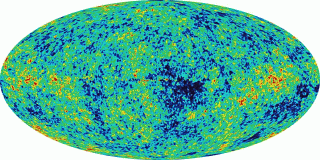How much dark matter is there in the Universe?
One parameter which allows us to decide upon the possible geometric
shape of the Universe and establish the ultimate destiny of the Universe is the average density of the matter present in the Universe.
|
|
|
Fig. 1: Possible geometric shapes of the Universe: spherical, flat, hyperbolic. |
Inflationary cosmological models ![]() predict a value of 1 for the Omega parameter, and a flat Universe. Given that, scientists deduce,
from the visible quantity of matter, an Omega value of 0.005, we can say that
dark matter
predict a value of 1 for the Omega parameter, and a flat Universe. Given that, scientists deduce,
from the visible quantity of matter, an Omega value of 0.005, we can say that
dark matter![]() should make up 99.5% of the mass of the Universe. But is it possible to verify that the density
of matter really corresponds to the critical density, as foreseen in the theory of inflation?
should make up 99.5% of the mass of the Universe. But is it possible to verify that the density
of matter really corresponds to the critical density, as foreseen in the theory of inflation?
The total amount of matter required in order to keep stars in galaxies and galaxies in superclusters is estimated to be 35% of that needed to obtain a Universe of euclidean geometry. It is also believed that this matter is subdivided as follows:
visible baryonic matter

0.5%
Invisible baryonic matter
4%
0.5%
non baryonic matter (eg. neutralinos )
30%
On the other hand, other studies (most recently the
WMAP experiment) have demonstrated that the small fluctuations in
temperature in the microwave
background radiation![]() have the characteristics expected in the case of a Universe with an energy density equal to
the critical density.
have the characteristics expected in the case of a Universe with an energy density equal to
the critical density.
What a strange Universe we live in! The idea that the visible Universe forms only half a percent of everything that exists
is hard to swallow.
So what is the remaining 65% of "density" which has nothing
to do with either visible matter or dark matter? We will look at this in the next section.
Carl Sagan was right when he said that we are made of stars, but now astrophysicists are telling us that the Universe is not!
| Fig. 2:This figure shows the fluctuations
in the temperature of the background cosmic radiation revealed by the
WMAP (Wilkinson Microwave
Anisotropy Probe)experiment. These fluctuations are very small: deviations of 1/1.000.000 from the average temperature value
(~ 2.73 oK).In the image in false colours, the red zones indicate the hottest areas and the blue zones the coldest,
in relation to the average value. It is a projection on an oval map of the distribution of
electromagnetic radiation (Credit:NASA/WMAP Science Team) |



